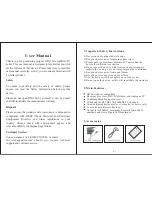
Device Description HG G-71450/1/3/5-A | English, Revision 02 | Date: 06.06.2019
37
Interfaces: CANopen® (HG G
-
71453) – Chapter 7
7.2 Node ID
2 Hex rotary switches protected by seal plugs in the housing of the transponder an
-
tenna can be used to adjust the CANopen® Node ID (see also Figure 9 on page 20).
Use a screwdriver to set the address in the range of 01 bis 7F and then close the
plugs tightly again. For the readjusted address to be used the antenna has to be
turned off and on again.
7.3 Default Values
The CANopen® interface is set to the following values in the delivery state.
7.4 Description of the Transmission Process Data Objects
(TPDO)
Fixed places are allocated for the measured values in the PDO. Dynamic mapping is
not possible. TPDO_1 is transmitted as a combination of the identifier 0x180 and the
node address. It is either sent cyclically (event time > 10ms) or only when the mea
-
sured values have changed (inhibit time > 3ms). In order to avoid excessive bus us
-
age, it is possible to set the so-called Inhibit time in the CAN menu of the serial mon
-
itor or with an SDO.
It contains exactly 3 bytes consisting of 16 bit transponder code and the status. The
latter is equal to the status as shown in the monitor program. The meaning of the
data is defined in Table 34 on page 37.
It is also possible to permanently deactivate a TPDO by selecting the asynchronous
mode (255) with inhibit time = 0 and event time = 0,
then store the parameters. In
addition, it is possible to temporarily deactivate/activate the TPDO by setting/delet
-
ing the highest ranking bit within the corresponding PDO COB identifier [1800,01].
Table 33
HG G-71453: CAN factory settings
Function
Default value
Posi filter
0ms
CAN baud rate
125kB
TPDO Event time
100ms
TPDO Inhibit time
3ms
Heartbeat time
1000ms
Autostart
1
Lowbyte first
0
Table 34
HG G-71453: Structure CAN transmitting object TPDO_1
Name
No. format
Value range (Hex)
Description
Code
Unsigned 16
0..0xffff
Code bits 0..15
Status
Unsigned 8
./.
Status bits (see
following below)
















































